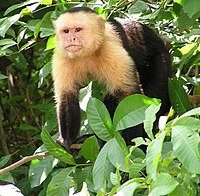
Photo from wikipedia
Abstract Play behavior is a significant trait of immature nonhuman primates (hereafter primates) that plays an important role in sensory, locomotor, socio‐cognitive, and developmental processes. It has been suggested that… Click to show full abstract
Abstract Play behavior is a significant trait of immature nonhuman primates (hereafter primates) that plays an important role in sensory, locomotor, socio‐cognitive, and developmental processes. It has been suggested that the function of play is to practice and improve motor skills related to foraging, avoiding predators, attracting mates, raising offspring, and strengthening the skills needed for the formation and maintenance of social bonds. From September 2009 to August 2010, we investigated the play behavior of 1–12 month‐old infant white‐headed langurs (Trachypithecus leucocephalus) a Critically Endangered primate species endemic to China. We carried out this study in the Guangxi Chongzuo White‐headed Langur National Nature Reserve, and recorded 4421 play bouts and 1302 min of play engaged in by seven infants. We found that infants of different ages exhibited different patterns of play behavior. Specifically, nonsocial play behaviors appeared at one month of age, social play behaviors at two months, and an expanded repertoire of social and non‐social play behaviors at three months of age. The frequency and duration of nonsocial play peaked at five months of age and then decreased, while social play gradually increased with age. Nonsocial play did not differ between the sexes, whereas social play showed sex specificity, with a higher frequency and longer duration of social play in male infants compared to female infants. In addition, male and female white‐headed langur infants appeared to prefer individuals of same sex as social playmates, but no obvious choice preference for a specific individual. In conclusion, we provide the first report of play behavior in a population of wild Critically Endangered white‐headed langurs. We suggest that age‐ and sex‐specific differences in play behavior of infants form the bases for age and sex‐based differences in the social interactions of adult langurs.
Journal Title: Ecology and Evolution
Year Published: 2022
Link to full text (if available)
Share on Social Media: Sign Up to like & get
recommendations!